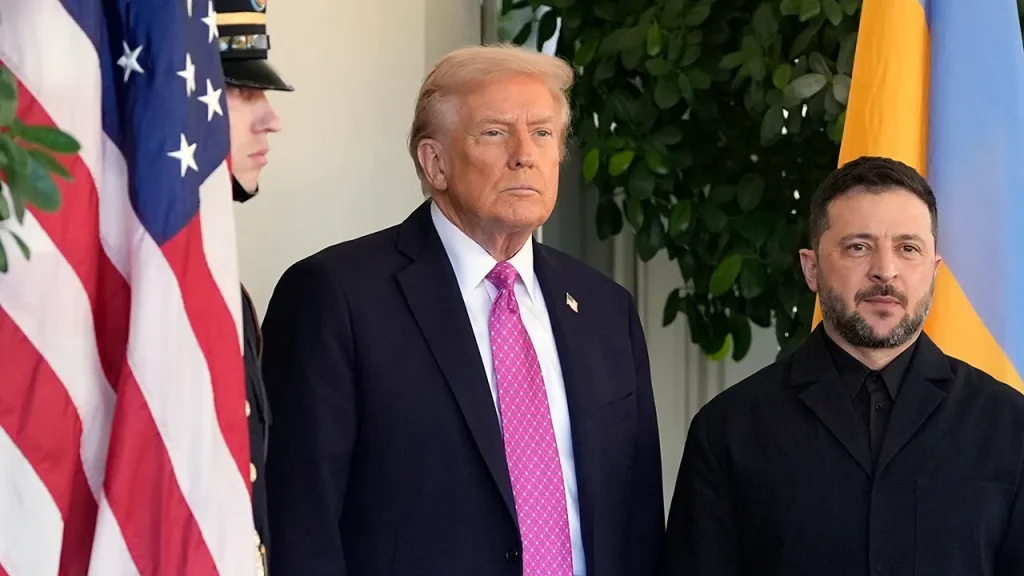Trump and Zelenskyy Meet Amid Ongoing Ukraine-Russia Conflict
In a significant diplomatic development, President Donald Trump hosted Ukrainian President Volodymyr Zelenskyy at the White House on Friday, just one day after a phone conversation with Russian President Vladimir Putin. During the meeting, Trump acknowledged the “tremendous bad blood” between the Ukrainian and Russian leaders, which he believes is the primary obstacle to reaching a peace settlement in the ongoing conflict. Despite this challenge, Trump expressed optimism, stating, “I think we are going to get it done,” suggesting his administration’s recent success in de-escalating tensions in Gaza might offer a blueprint for resolving the Ukraine crisis as well. The timing of these diplomatic engagements highlights the delicate balancing act the U.S. is attempting to maintain between supporting Ukraine while simultaneously engaging with Russia to potentially broker peace.
The meeting with Zelenskyy, his third White House visit this year, focused heavily on Ukraine’s defensive needs as the country continues to face relentless Russian aerial bombardments of civilian infrastructure. Zelenskyy’s primary request was for American Tomahawk missiles, sophisticated long-range cruise missiles that could significantly enhance Ukraine’s strike capabilities against Russian targets. “We need Tomahawks, and we need a lot of other things that we’ve been sending over the last four years to Ukraine,” Trump noted during the meeting. For Zelenskyy, securing these advanced weapons systems represents a crucial step in Ukraine’s defense strategy against Russia’s continued aggression, particularly as Russian forces target cities, energy infrastructure, and hospitals across Ukraine.
The context of this meeting is particularly noteworthy coming just after Trump’s conversation with Putin, during which the American president claimed “great progress” was made, though he provided few specifics about what this progress entailed. The call resulted in an agreement for the two leaders to meet in person in Hungary, marking another step in Trump’s direct engagement with the Russian president. Prior to the call, Trump had hinted he “might have to speak” with Putin regarding the potential deployment of U.S. Tomahawks near Russian borders, which some interpreted as an implied threat or negotiating tactic. However, in Trump’s public accounting of their discussion, neither Tomahawks nor defensive aid to Ukraine were explicitly mentioned.
Russian officials, however, offered a different perspective on the conversation. According to Russian presidential aide Yuri Ushakov, Putin firmly opposed the provision of Tomahawk missiles to Ukraine during the call. “Vladimir Putin reiterated his thesis that Tomahawks won’t change the situation on the battlefield, but they will cause significant damage to relations between our countries. Not to mention the prospects for a peaceful settlement,” Ushakov told reporters, according to Reuters. This stark contrast in messaging highlights the complicated diplomatic terrain Trump is navigating as he attempts to maintain communication channels with both Ukraine and Russia while pursuing what his administration characterizes as a path toward resolution.
Meanwhile, Zelenskyy continues to emphasize Ukraine’s urgent need for defensive capabilities. In a post on social media platform X following Trump’s call with Putin, Zelenskyy wrote: “Nothing has changed for Russia – it is still terrorizing life in Ukraine. Therefore, every air defense system for Ukraine matters – it saves lives. Every decision that can strengthen us brings the end of the war closer.” This statement underscores the Ukrainian perspective that robust military support remains essential to their survival and ultimately to achieving a favorable peace settlement. Zelenskyy’s persistence in seeking American military aid comes despite what were reportedly tense exchanges during his previous White House visit in February, when Trump, Vice President JD Vance, and Zelenskyy were described as having “sparred” during their meeting.
As these diplomatic efforts unfold, questions remain about the feasibility of Trump’s approach to resolving the conflict. The administration appears to be leveraging its recent diplomatic success in Gaza as a model for Ukraine, though the situations differ dramatically in scope, complexity, and geopolitical significance. The fundamental tension between Putin’s expansionist ambitions and Ukraine’s fight for sovereignty presents a formidable challenge to any peace process. Additionally, the issue of military aid—particularly advanced systems like Tomahawk missiles—remains contentious, with Russia viewing such support as provocative while Ukraine considers it essential to their defensive capabilities. As Trump continues his simultaneous engagement with both leaders, the international community watches closely to see whether these diplomatic maneuvers will lead to meaningful progress or further complicate an already complex conflict that has caused immense human suffering and reshaped the European security landscape.


